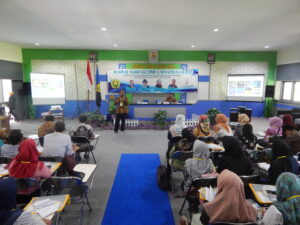 Department of Physics, Faculty of Mathematics and Natural Sciences, University of Jember, Second National Seminar of Physics (SENAFIS) 2017 with the theme “Improving Physics Contribution and Its Application In The Framework Towards IPTEK Aspiration in Global Era” on Friday – Saturday (17-18 November 2017) Dr. Agus Rubiyanto, M.Eng.Sc. Professor of Integrated Optics and Optoelectronics who is also Dean of Faculty of Science ITS Surabaya, Dr. Dwa Desa Warnana, S.Si, M.Si. from ITS Surabaya and Febdian Rusydi, S.T., M.Sc., Ph.D. from UNAIR Surabaya. The first day of the Second SENAFIS event in 2017, a workshop was held at the Physics Auditorium. In his speech, Dean of FMIPA Universitas Jember Drs. Sujito, Ph.D. opened the event to convey the participants of the workshop consisting of undergraduate and graduate students of Physics to explore the science of the speaker. “Do not just look for certificates for SKPI, but get knowledge from the speakers who are competent in their field” he explained. The Dean is also grateful to all the presenters and to the organizers especially because of SENAFIS is one of the factors that make the Physics Department able to achieve accreditation A. “Department of Physics and FMIPA intend to continue to work together in all things with ITS and UNAIR which is the institution of the speakers on this SENAFIS” he concluded.
Department of Physics, Faculty of Mathematics and Natural Sciences, University of Jember, Second National Seminar of Physics (SENAFIS) 2017 with the theme “Improving Physics Contribution and Its Application In The Framework Towards IPTEK Aspiration in Global Era” on Friday – Saturday (17-18 November 2017) Dr. Agus Rubiyanto, M.Eng.Sc. Professor of Integrated Optics and Optoelectronics who is also Dean of Faculty of Science ITS Surabaya, Dr. Dwa Desa Warnana, S.Si, M.Si. from ITS Surabaya and Febdian Rusydi, S.T., M.Sc., Ph.D. from UNAIR Surabaya. The first day of the Second SENAFIS event in 2017, a workshop was held at the Physics Auditorium. In his speech, Dean of FMIPA Universitas Jember Drs. Sujito, Ph.D. opened the event to convey the participants of the workshop consisting of undergraduate and graduate students of Physics to explore the science of the speaker. “Do not just look for certificates for SKPI, but get knowledge from the speakers who are competent in their field” he explained. The Dean is also grateful to all the presenters and to the organizers especially because of SENAFIS is one of the factors that make the Physics Department able to achieve accreditation A. “Department of Physics and FMIPA intend to continue to work together in all things with ITS and UNAIR which is the institution of the speakers on this SENAFIS” he concluded.
Wokshop schedules three themes: Geophysical Methods for Disaster Mitigation by Dr. Dwa Desa Warnana, S.Si, M.Si. in Physics Lecture Room, Optoelectronics Application in Medical Physics Instrumentation by Prof. Dr. Agus Rubiyanto, M.Eng.Sc. in the SCL Physics Room, and the DFT Method for Biomaterials research by Febdian Rusydi, S.T., M.Sc., Ph.D at the Computational Physics Laboratory. This workshop is expected to collaborate with the Tugas Akhir (TA) students can also support the ability of graduates who are competitive so as to be able to open employment opportunities.
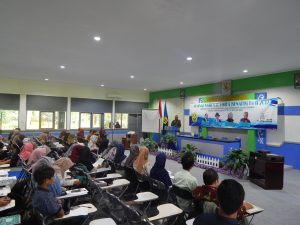 |
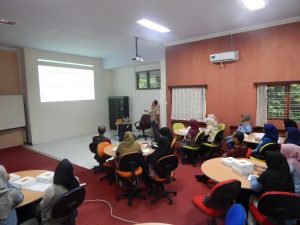 |
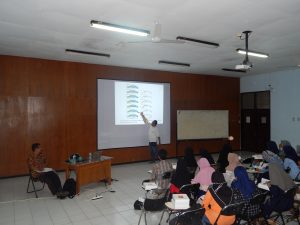 |
 |
Dokumentasi Workshop SENAFIS ke-II Tahun 2017
The opening of Second SENAFIS 2017 on Saturday was officially opened by Dean of FMIPA University of Jember. “SENAFIS can be upgraded to an international seminar of cooperation with ITS and UNAIR” he said. Head of Department of Physics FMIPA Dr. Lutfi Rohman, S.Si, M.Si. as the host of the SENAFIS activities hope the seminar participants can make this event to become a forum in exchange of knowledge and science. In SENAFIS reporting, Chairman of the Organizer Bowo Eko Cahyono, S.Si., M.Si., Ph.D. proud because this national seminar can be followed by participants from several islands in Indonesia. “SENAFIS 2017 followed from several universities spread from the island of Sumatra to Nusa Tenggara and some of them from BATAN” he explained. As an opening, participants are presented Jember dance from Department of Physics’s students.
Plenary Session is started by Prof. Dr. Agus Rubiyanto, M.Eng.Sc. from ITS Surabaya with title material “Prospect Development of Medical Physics in Indonesia” with moderator Dra. Arry Y. Nurhayati, M.Si. “The need for medical physicists in Indonesia is quite high, because every hospital is needed as many as 3 medical physicists” he explained. Currently there are 300 Medical Physicists, while the hospital is 2,609, so it still lacks approximately 7,000 Medical Physicists in Indonesia. Therefore, medical physics education at both bachelor and magister level is needed in Indonesia. Medical Physics itself is a branch of physics related to medicine, but in the medical service the most prominent physics charge today is in the field of Radiotherapy, Diagnostic Radiology, and Nuclear Medicine. So it can be said that the embryo of Medical Physics began to grow in these three fields.
Theme: “Urban Geophysics: The Application of Geophysics in Sustainable Urban Development” by Dr. Dwa Desa Warnana, S.Si, M.Si. became the next session with moderated by Agus Suprianto, S.Si, M.T. “Geophysical applications have made a significant contribution to produce subsurface information in urban areas” said this ITS lecturer. The application of geophysics in this field of study is referred to as urban geophysics. Some examples of developing and implementing urban geophysics in urban management in Surabaya: investigation of microtremor methods associated with Surabaya’s geological and urban hazards, and application of Ground Penetrating Radar (GPR) methods to assist Surabaya’s urban infrastructure.
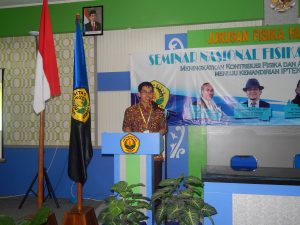 |
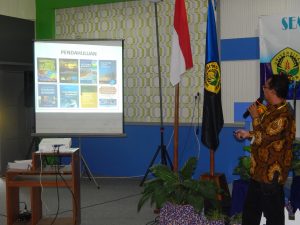 |
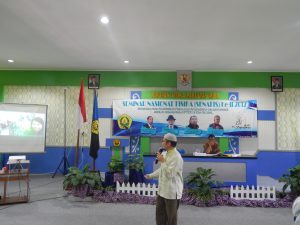 |
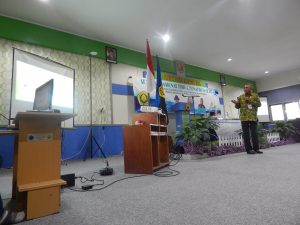 |
Documentaion of SENAFIS ke-II 2017
Febdian Rusydi, S.T., M.Sc., Ph.D from UNAIR with the theme “Enriching Basic Research with Density Functional Theory”. Density Functional Theory (DFT) can be defined as a technique in quantum mechanics to solve Schroedinger’s many electron equations in ab-initio. “DFT enables us to study the properties of materials on the basis of the electronic configuration of the material.The implementation of DFT on computer programs proves to be cheaper with precision and precision results maintained” the febdian explanations are present along with his assistants and students.
The host through the Dean of FMIPA University of Jember Drs. Sujito, Ph.D. who specializes in Material Physics, delivered the presentation with the theme: “Green Composites Cellulose Based Bacteria and Its Potential as a Ballistic Vest Industrial Material” which is the result of analysis with Drs. Achmad Sjaifullah, M.Sc., Ph.D. from Chemistry field who is also Vice Dean I of FMIPA and also one of the lecturer of Civil Engineering, ITS Candra Irawan. “The utilization of bacterial cellulose (nata de coco), bagasse fiber, and hair cut waste (LPR) as the base material for the fabrication of green composites will be done in order to obtain a composite material that is environmentally friendly, robust, and light.” he explained. Composite materials with synthetic fiber base materials and nonbiodegradable resins have been widely developed for many applications ranging from internal parts of the automotive industry to home appliances.
After plenary, the parallel sessions are divided into groups. Group A: Theoretical Physics & Computational-Nuclear Physics, Group B: Geophysics – Environmental Physics (Remote Sensing, Acoustics), Group C: Biophysics – Health Physics, Group D: Material Physics, Group E: Electronics and Instrumentation, Group F: Physics and Group G: New and Renewable Energy Physics. Presenter delivered the presentation with moderated students from the Department of Physics.
